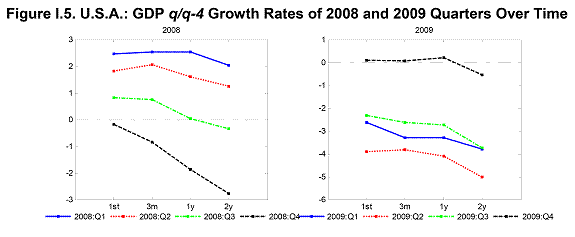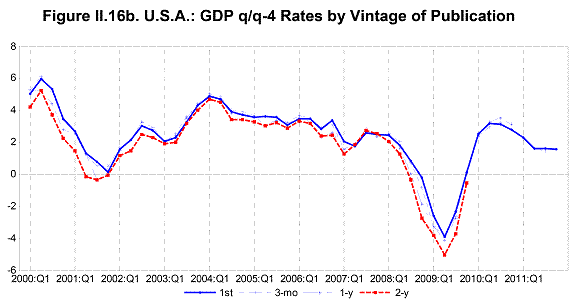An interesting new working paper, “Quarterly GDP Revisions in G-20 Countries,” by Manik Shrestha and Marco Marini, documents the fact that at the end of 2008, statistics understated the true extent of U.S. GDP decline.
The Surprise in 2008Q3-Q4 and Assessing the ARRA’s Impact

Source: Shrestha and Marina, “Quarterly GDP Revisions in G-20 Countries,” IMF Working Paper No. 13/60. The observations pertain to the first release (1st), the release three months out (3m), one year (1y), and two years (2y).
Notice how the the 2008Q3 estimate moved from positive growth to negative. As the authors observe:
We can appreciate how earlier estimates of quarter 2008:Q4, epicenter of the crisis, have been revised downward in both the U.S.A. and the U.K. … this pattern has continued for all the quarters in 2009 in the U.S.A. …
Why is this of interest? Recall the oft-repeated It’s important to understand that the Bernstein-Romer estimate of the impact of the ARRA was conditioned upon the understanding of the extent of the downturn as of January 9, 2009, at which time only the 2008Q3 estimates were available (the 2008Q4 advance release would be published at end of January). The surge in unemployment (c.f. Okun’s law) as output dived was taken as failure of the ARRA, rather than the outcome of conditioning on an overly optimistic assessment of the state of the economy. This is true despite the fact that Bernstein and Romer write explicitly “Table 1 shows that we expect the proposed recovery plan to have significant effects on the aggregate number of jobs created, relative to the no-stimulus baseline.” (p. 3).
So one cannot directly assess the impact of a policy without considering on what assumptions the baseline forecast was conditioned on, as discussed here. This point also applies to other projections. [1]
Implications for Assessing Forecasts
From the conclusion to the paper:
The second finding is that overestimations in the first release of quarterly GDP have been more frequent for the 2008–2009 quarters compared with the quarters of the previous years. Negative [mean revision] values are found for eight countries in the post-2008 period, compared with only four countries in the pre-2008 period. More negative values of the MR statistics after 2008 are noted for countries with a significant fall in the GDP during the years 2008–2009 (in particular U.S.A., and Japan), while for the U.K. the mean revision to the first estimate of quarterly GDP growth after two years is confirmed to be around zero despite the strong economic downturn …
The result that pre-2008 revisions are approximately mean zero for the U.S. is consistent with Faust, Rogers and Wright (JMCB, 2005) (ungated wp version).
This finding of negative mean revisions post-2008 (although based on a relatively few observations) suggests that one needs to be very careful about making strong conclusions regarding the state of the economy on the basis of advance GDP data, e.g., in or out of recession, at least for now. As economic conditions stabilize, there is no guarantee that the tendency toward negative mean revisions will persist.
Moreover, it would be wrong to conclude there is no information in U.S. advance GDP data, as the growth rate from the advance release correlates with the growth rate from the estimate 2 years out 88% of the time, even in the post 2008 sample (and 94% of the time in the pre-2008 sample). This finding is illustrated in Figure II.16b:

Source: Shrestha and Marina, “Quarterly GDP Revisions in G-20 Countries,” IMF Working Paper No. 13/60.
So, if I understand the argument, Bernstein-Romer were making decisions based on data that 4 years later are proven to be hugely in error and so they should be forgiven for making their mistakes in projection.
If the Bernstein-Romer decisions did not have any impact on the economy I might be able to buy the argument – they were just economists led astray by the data – but in a command economy such as we have in the US today these decisions have huge life or death consequences in the lives of real people.
Hayek was very eloquent in debunking the command economy as it makes decisions based on faulty theory and data. There is a knowledge problem.
Menzie, thanks for once again giving us the data that proves the truth of Hayek’s observations. Now if we can only get the autocrats to understand (but then again where would they get the big bucks if they were constrained?)
Did anyone notice that the Senate passed (is passing?) a budget for the first time in years and their pay depended on it.
Are Mssrs. Chinn and Hamilton willing to concede the principle that politicians behavior can be influenced by the nature of their pay?
I think this may be helpful when thinking about the budget: http://capitalgainsandgames.com/blog/stan-collender/2722/few-quick-hits
correlation does not always imply causation,
especially with just one observation.
If you are addressing your comment to me, Spencer, we have in fact three data points:
– bureaucrats get bonuses in Singapore, who will be twice as wealthy per capita as the Germans by the end of the decade
– In California, in 2011, the state legislature passed a budget on time for the first time in 25 years under the threat of not receiving their pay until they produced a budget
– US Senators, supposedly a group wealthy enough not to care about money, passed a budget in order to receive their pay.
Adam Smith does not become inapplicable just because someone is elected to office. Pay for performance is the single most important means we have to improve governance and the lot of millions of people. It’s high time we started to discuss it.
Spencer,
It does when it come so money!!!!
Thanks for the Steven Kopits.
Steve Kopits The Constitution prohibts Congress from changing its salary…up or down. What you’re seeing is a stunt to impress the Tea Party crowd, who ironically enough are largely ignorant of what the Constitution actually says.
Slugs –
Congress can set the pay for the subsequent Congress.
But, if you read my recurring comments on this topic, you’ll know that I favor initial introduction of incentive programs through the IMF as part of loan conditionality. This finesses the whole setting-pay issue, and further puts the IMF in the role of managing these incentive systems, which will, in fact, require revisions and expansions over time.
As I have stated before, the only job which I truly covet would be “Director, Governance Incentive and Compliance Programs, IMF”. This person would have a greater opportunity to help more people than any other single person on the face of the planet.
yeah, sorry, i am inclined to agree that the fact that the data were revised does not excuse the Bernstein-Romer estimates. Point estimates are just that. Revisions to GDP are common. The real missing piece at the time was a useful discussion of whether the point estimates likely understated or overstated growth, and what a follow-on plan might be if its worse than imagined.
Are we in a recession? Not at the moment… no.
Here is a link to a graph of my UT equation.
https://research.stlouisfed.org/fred2/graph/?graph_id=111871&category_id=0
UT is a value for total unused available factor utilization (labor and capital). The key word is available, because beyond a certain point, labor and capital are not available to the economy. Effective demand based on labor share of income won’t allow more utilization of labor and capital.
The equation is…
UT^2 = ls*0.78 – cu*(1-u)
UT is non-negative meaning that below zero, factor utilization is not available.
ls = labor share of income: business sector (2005=100)
cu = capacity utilization rate
u = unemployment rate
You will see in the graph that the line comes close to zero than heads back up.
The most important thing to see in this graph though is the shaded areas for the recessions of the US. Once the value for UT starts rising, we have a recession. and as we can see in the graph, UT has not started to rise yet. However, it is reaching its lower limit, which means the economy has reached its limit of being able to utilize labor and capital. A contraction will eventually occur from this level.
A brief description of the equation is this…
Effective demand (ls*0.78) determines the limit for the combined utilization rates of labor and capital (cu*(1-u)).
The questions you may ask yourself are…
What are the dynamics behind this equation? How does labor share of income limit factor utilization rates?
The bottom line is that we are not in a recession… yet.